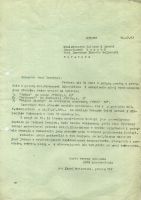Autograph for piano (1980)
Autograph was written at a time when Tomasz Sikorski worked hard on developing his own musical language, especially when it came to the piano. It was precisely in the early 1980s that he composed Euphony (1982) and Rondo (1984), and in the late 1970s – Music in Twilight (1977–78) and Hymnos (1979). The premiere of Autograph took place in March 1981 in St. Petersburg, Florida. The pianist was Steve Monague.
Autographis a short piece with a simple module structure. Its duration is specified by the composer at about 5 minutes. The work consists of three sections (A, B and C), making up the following formal structure:
A B A1 B C A
Repetitions of sections A and B have exactly the same material, while changes in A1 affect the sound plane made up of accented notes in long values which appear on a lower dynamic level.
Works from the “self-portrait” or “autograph” category are often associated with a suspicion or even expectation that they will contain some hidden message, some encrypted, sensational information about the composer. This type of “discovery” may be made by those inquisitive listeners who will check the pitches used in the score. They will find out that the only element in the twelve-note scale not utilised in Autograph is the note E flat. This omission could, therefore, be read as a kind of symbolic signature of the composer [in Polish “E flat” is noted as “es”, i.e. the way the letter “S” is pronounced]. Whether Sikorski intended to draw the listeners’ attention to this “missing” note, whether there is some deeper meaning behind it or whether it is just a coincidence – we will probably never know. Perhaps the composer chose the title thinking about a planned premiere before an audience for whom his work was largely unknown. Autograph was to be a musical sample, demonstrating its author’s musical “handwriting”. The length or the piece and the relatively small number of technical devices used in it suggest that it should be treated a signature of the composer’s piano writing rather than as the essence of his compositional style in general.



